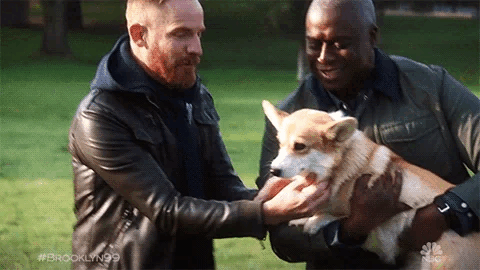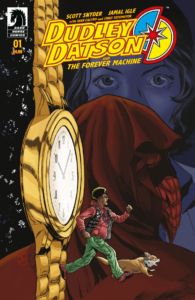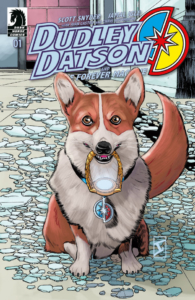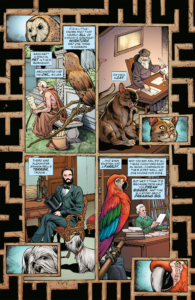Comic Review:
Dudley Datson and the Forever Machine
Publisher’s Summary:
From New York Times bestselling creators Scott Snyder and Jamal Igle comes this rollicking sci-fi adventure story about a boy, his dog, and a machine that controls time and space! What could go wrong?
Have you ever wondered why all the great figures in history had a pet companion, and if they were all running from the same mysterious threat? Such questions have never crossed the mind of Dudley Datson, a fifteen year-old with a penchant for invention. But when dastardly foes turn his world upside down, Dudley is going to have to start facing things beyond his wildest imagination in this modern day fable.
Collects the comic book series Dudley Datson and the Forever Machine #1–#3, originally published by Comixology Originals.
Creators
Writer: Scott Snyder
Penciller: Jamal Igle
Inker: Juan Castro
Colorist: Chris Sotomayor
Letterer: Tom Napolitano
Cover Artist: Jamal Igle
Genre: Action/Adventure
Review:
While it may be shocking that I’m not all that familiar with Scott Snyder’s work (I read American Vampire back in the day), I’ve known Jamal Igle and Chris Sotomayor for many years, to be transparent about that.
Needless to say, it was Igle’s name on the press release that first caught my attention. I know if there’s going to be work done in the super-powered/sci-fi world, he has the chops for it. The name of the titular character, Dudley Datson, stood out as well. I started thinking about the old Datsun cars and connected dots about cars and sci-fi to Back to the Future. My mind took a journey before I had read a single page and I think that says a lot about seeing only the cover images.
Perhaps, I’m an “easy fan,” because the moment I read the first panel, I had a sense that I would love this story. Why? Quite simply, a narrator discusses Great Pets in History. Technically, he’s talking about the owners, the greatest inventors of all time; and each one had a special pet. If there are high profile pets in a story, I’m probably1 going to like it, but I do like to be warned if they’re going to die2.
Spoiler Alert since Does the Dog Die does not cover the Dudley Datson comic (wow, alliteration much?), you may click to expand the reveal since a dog is a main character.
Here’s your palette cleanser:

Dudley Datson has much more to worry about than whether he’ll get a date to the prom. He’s a genius among other genius kids at a special school, Brooklyn Academy of Engineering, where he’s in the Young Inventors Society.
Readers are quickly introduced to Ohno, Dudley’s best friend; his father; and his favorite teacher, Dr. Shae. It’s his teacher’s dog, Daedalus that becomes Dudley’s “old master guide” for this hero’s story. That’s more than a play on the Campbell formula for heroes. Daedalus is genuinely older than you might expect.
Dudley can’t figure out why this fluffy-butt Corgi seems to hate him. Daedalus seems to only bark angrily at the stressed-out black teenager. As soon as they begin to understand each other better, their quest leads to an exchange in valuable lessons about motivation.
Dudley feels extreme guilt for not being able to earn huge dollars as a teenage inventor in order to provide for his family. These sorts of character traits tend to lead one to the path of the workaholic who regrets not spending enough time at home or with friends. Daedalus has many surprises for Dudley as they face the conquering of Earth by an evil overlord who is human, but he decided to side with an alien race called Prometheans.
If you can’t tell by now, this is fan fiction adding, mixing, and restructuring the well-known Greek mytho of Daedalus, his son Icarus, and his nephew Perdix. Of the changes, naming the aliens who come to enslave humans in order to power the Forever Machine, Prometheans, feels like an odd choice. In Greek legend, Prometheus defied the Gods and took fire from Olympus which he gave to mankind to cultivate advances in their civilization. These Prometheans want to use humans if you can imagine an absurdism of hamsters running on wheels to generate enough to power the world’s energy grids. Absurdism isn’t a storytelling flaw—don’t get me wrong, we use it all the time in our fantasy worlds.
The betrayer of mankind dons a superpowered golden suit of armor with a red cloak and hood. His face is masked like that of a bird in this armor. Birds can represent so many things in stories: freedom (defying gravity); American patriotism (the bald eagle); wisdom (Athena’s owl); peace (white doves—specifically white ones, because you’d never get away with calling a New York rock pigeon a symbol of peace); prophecies or harbingers (crows, ravens, and other black birds); beauty and art (swans—in reality, they are vicious and mean). By no means, is this a complete list. Having been through our own pandemic of the COVID-19 virus strains, the symbolism of the plague doctor and nurse masks with long beak shapes has become quite popular again. For the unaware, the beak of those masks contained incense so that one could get close to decaying bodies exuding the odor of rotting flesh and disease.
As Corgi Daedalus tells stories of the past, readers are gifted a style shift in the artwork in pencils, inks, and colors—a muted color palette, faux distressing of panels, period appropriate wardrobes and environments. Right on the first page, a reader might not notice the first time they read through the comic that page borders feature the Labyrinth. This happens again in quite a different way when Dudley becomes trapped in his own nightmare. There are organic yet “alien” shapes to the panels outside borders. People look more like political cartoon caricatures than Igle’s trademark style which itself has evolved from perfectly built superheroes to diverse and realistic people with unique senses of expressing their personalities. Even the dog has a vast range of emotions and actions.
Contrary to television, Chris Sotomayor’s color scheme for Brooklyn is bright and vivid. Even the emotional scenes where our protagonist Dudley has to slow down and contemplate his crisis at home, the colors stay consistently hopeful and cheery. His choice in drawing attention away from an evil act (a dead body) and to the killer is pulled off by making the victim colored by a jewel-toned gradient in a shadow compared to the splash page of full color that showcases who did it.
I must give a shout out to Napolitano’s lettering. As someone who can have difficult vision and eye strain, the digital version was incredibly easy to read. I never mixed up the order of speakers. Daedalus has legible blue narration boxes. The typeface throughout is various versions of all capital letters in soft “traditional” comic styles. There are subtle changes for emotions such as a scared woman’s dialog being just a hint smaller than the heroes’ and the villain’s speech.
Snyder’s storytelling could be used by anyone interested in writing comic or prose. Each issue does vary slightly, but there’s a critical path followed. This is something award-winning author and professor, Jane K. Cleland calls the plot roadmap. In her book, Mastering Suspense, Structure, and Plot: How to Write Gripping Stories That Keep Readers on the Edge of Their Seats (*affiliate link), Cleland explains what Scott Snyder is doing to keep you turning the page. It’s in the formula of “TRDs” or twists, reversals, and dangers. You can get a glimpse of that roadmap in one of my writing blog posts that was written the last time there was an election making everyone sick (2016).
Here’s a shortened version of my analysis of Snyder’s plot structure for chapter one:
- 1-2 pages of flashback
- 1 page showing the hero’s modern world (first) regret and embarrassment
- Break for Title Page
- 3 pages that explain how we got to that embarrassing moment on page 3
- Scene change for 3 pages
- 2 pages shifting to another POV (point of view) in this case, the villain
- 1-2 pages back in the present timeline
- 2 pages of slow, emotional pacing while hero turns his attention to what’s stressing him out before the interference of the “old sage” character (the dog); it’s sad, moody, but loving.
- Scene changes and over the next three pages the protagonist goes from taking corrective action (regarding that embarrassing moment) to being thrown into quick thinking during the inciting incident.
- Last two pages of issue one show the death of a character who is forced to pass the burden on to the young, inexperienced protagonist calling him to action that requires him turning his focus away from home in order to serve the greater good.
And that, my friends, is how you get people hooked. Snyder is indeed a young master of page-turns. Overall, this was a fun read that included a super-Corgi as a main character. Bonus points for that. The story utilizes our past and present day hopes, dreams, and mistakes as the caretakers of this world.
Rating: 5 stars

Footnotes:
1. I had a difficult time reading Stray despite it being a solid story with Don Bluth style; it was incredibly violent for the animals. Also, I have Feral by that same team and haven’t braced myself enough to read it yet.




